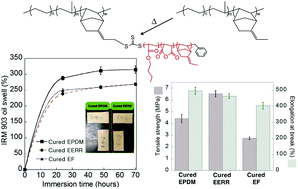An efficient chain transfer reaction of the trithiocarbonate unit as a tool to prepare a functional polyolefin: a post-polymerization modification of ethylene–propylene–diene terpolymer for improved oil resistance†
Abstract
Polyolefins are one of the most widely used polymer materials today, due to their low price and outstanding performance. However, despite their versatility, the applications of polyolefins have often been limited because of their low polarity and lack of functionality. In this study, a novel strategy to modify polyolefins is applied to an ethylene–propylene–diene terpolymer (EPDM) by using an efficient radical chain transfer reaction of the trithiocarbonate (TTC) unit. First, pentadecane and dibenzyl trithiocarbonate (DBTTC) are selected as model compounds to verify the strategy, successfully affording pentadecane-graft-benzyl TTC. Poly(n-butyl acrylate-co-maleic anhydride-co-5-ethylidene-2-norbornene) [poly(nBA-co-Mah-co-ENB)] containing a TTC unit in the polymer chain is synthesized as a functional polar polymer through a controlled/“living” radical polymerization technique using DBTTC as a reversible addition–fragmentation chain transfer agent. EPDM-graft-poly(nBA-co-Mah-co-ENB) is then successfully prepared through a “grafting-onto” melt process by using an internal mixer, exhibiting improved oil resistance and excellent mechanical properties. This study demonstrates a novel methodology to modify polyolefins to have improved properties, which may widen the application and success of polyolefins in commercial markets.



 Please wait while we load your content...
Please wait while we load your content...